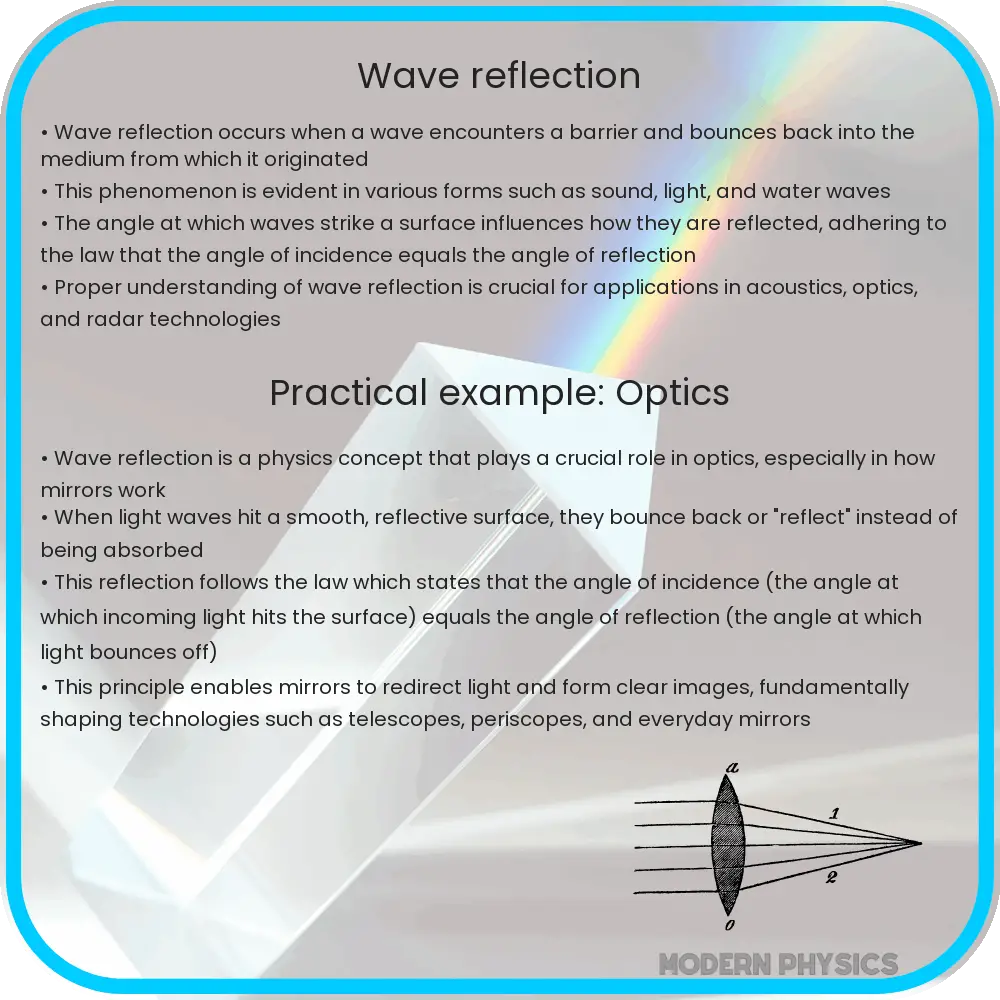Wave reflection in acoustics is the bouncing back of sound waves when they hit surfaces, crucial for soundproofing and audio engineering.

Understanding Wave Reflection in Acoustic Principles
Wave reflection is a fundamental concept in the physics of sound. It occurs when a sound wave encounters a surface or boundary that does not absorb all of its energy, causing some or all of the wave to bounce back into the medium from which it originated. This phenomenon influences the behavior of sound in a variety of environments, from large concert halls to small rooms, and is crucial for various applications such as soundproofing and audio engineering.
The Basics of Sound Behavior
Sound waves are longitudinal waves consisting of compressions and rarefactions that travel through a medium such as air, water, or solids. A key characteristic of sound waves, like all waves, is their ability to reflect off surfaces. The reflection of sound waves involves two main types: specular reflection and diffuse reflection.
- Specular Reflection: This occurs when a sound wave hits a smooth, hard surface and bounces off at the same angle at which it hit the surface, similar to a light ray reflecting off a mirror. The angle of incidence (the angle at which the incoming wave strikes the surface) is equal to the angle of reflection (the angle at which the reflected wave leaves the surface).
- Diffuse Reflection: This type of reflection occurs when a sound wave hits a rough or irregular surface. Rather than reflecting the sound in a single, predictable direction, the roughness causes the sound wave to scatter in many directions. This scattering effect is essential for achieving good acoustics in a room as it helps distribute sound evenly.
Mathematical Description of Wave Reflection
The behavior of reflected sound can be described mathematically using the law of reflection. The law states that:
θi = θr
where θi is the angle of incidence and θr is the angle of reflection. Both angles are measured relative to a line normal (perpendicular) to the surface at the point of impact.
Additionally, the intensity of the reflected sound wave depends on the acoustic impedance of the medium and the surface material. The ratio of the acoustic impedances of the two mediums can be used to calculate the reflection coefficient (R):
R = (Z1 – Z2) / (Z1 + Z2)
Here, Z1 and Z2 are the acoustic impedances of the media on either side of the boundary. The reflection coefficient describes how much of the sound wave’s energy is reflected by the surface. A coefficient of 1 indicates total reflection, while 0 indicates no reflection.
Real-World Applications of Wave Reflection
Understanding and manipulating wave reflection is crucial in many fields. In architectural acoustics, for example, designers use materials with specific reflective properties to enhance sound quality in a space or to isolate sound to prevent it from escaping or entering a room. In the field of audio engineering, strategically placed surfaces can be used to manage sound reflections to achieve the desired audio effects during recordings.
Another significant application is in the design of musical instruments, where the shape and material of the instrument are chosen to create beneficial reflection patterns that enhance the quality of sound produced.
In all these cases, a thorough understanding of wave reflection not only helps in controlling sound but also in enhancing the auditory experience in various environments. Continuing our exploration, we shall delve into how these principles are applied, examining specific case studies that illustrate the practical benefits of effective sound wave management.
Case Studies in Wave Reflection
Let’s examine some practical examples of how knowledge of wave reflection is applied in real-world scenarios:
- Concert Hall Design: The renowned Sydney Opera House, for instance, incorporates specific architectural elements designed to optimize sound reflections. The curved surfaces inside the concert hall help in evenly distributing sound waves throughout the venue, ensuring that every audience member experiences the same sound quality, regardless of their seating position.
- Recording Studios: To achieve clear and well-balanced recordings, studios are often fitted with diffusive panels that scatter sound waves. These prevent the formation of echo and reverb, which can distort the quality of recorded sound. Angled surfaces and varying materials help create an ideal acoustical environment.
- Home Theater Systems: Strategic placement of speakers and use of sound-absorbing materials around television and sound systems in homes are applied to enhance the listening experience. By controlling reflections, homeowners can achieve theater-like sound quality in their living rooms.
Conclusion
Wave reflection plays a pivotal role in the quality and distribution of sound across various environments, from natural settings to man-made structures. Understanding the principles of wave reflection helps in designing spaces that can manipulate sound for desired outcomes, whether it’s in architecture, entertainment, or technology. With principles grounded in physical acoustics, designers can create environments that not only meet the practical needs of sound management but also enhance the auditory experience. As we continue to refine our understanding of these principles, the potential to innovate and improve acoustic environments expands, promising better sound quality and distribution in spaces ranging from the smallest rooms to the largest arenas.
By mastering the fundamentals of wave reflection and continuing to apply these principles creatively, professionals and enthusiasts alike can ensure that sound works to the advantage of spaces and their occupants, making every auditory experience enriching and enjoyable.
